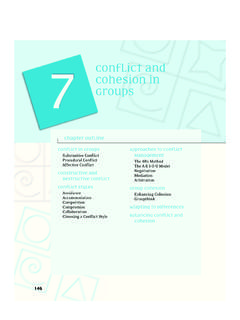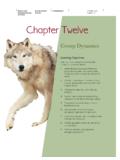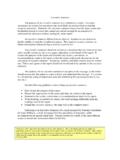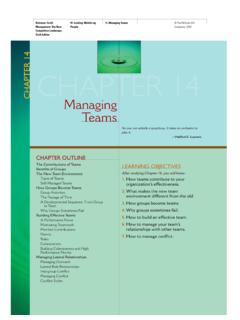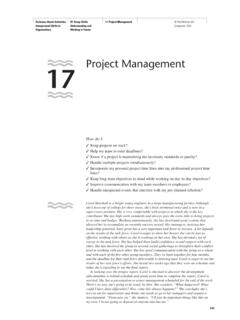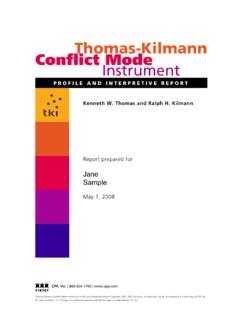Transcription of University of Phoenix - apollolibrary.com
1 Managing Conflict in Learning Teams 1 University of Phoenix Managing Conflict in Learning Teams Shelia Porter, Conflict: friend or foe? It can be either of the preceding, but most people usually categorize it as the latter. Conflict in itself is not the problem. It is, rather, our reactions to it that determine the impact, and thus cause us to characterize it as a negative experience. Conflict or divergence can be destructive or it can be constructive. It is up to the people involved in the conflict to manage the outcome. Conflict is inevitable and at times stimulates beneficial or creative thinking. Often times conflict is a signal that people are making different assumptions about what has thus far gone unspoken.
2 When that happens, conflict gives them an opportunity to articulate their assumptions and then to figure out a way to come to agreement. In a Learning Team situation, conflict can arise when the original agreement to work together does not address enough specifics about exactly how and when team members will accomplish individual tasks. This will inhibit achieving overall team goals. Understanding that conflict can, will, and perhaps should occur puts a greater emphasis on the Learning Team Charter. It is much more than a formality or a document to be completed quickly, signed, and filed away. It serves as a roadmap the team can use to arrive at its destination.
3 When the Learning Team Charter section on conflict management is completed in a conscientious manner, it will provide the team with an agreement about how conflicts will be resolved for the good of the team and possibly reduce the negativity associated with conflict. Managing Conflict in Learning Teams 2 The Learning Team Charter requires the team to focus on the potential conflicts that may arise between or among team members in each course. Team dynamics and conflict can differ from course to course. Creating a new Charter for each course is essential. What conflicts can the team anticipate? How will the team deal with these and other conflicts that may arise?
4 The right answers to these questions may be as varied as the individual personalities serving on the team. As an effective Learning Team, however, individual team members need to agree on the decisions and come up with a collective resolution that all team members will support. An important benefit of taking time to carefully complete the Learning Team Charter is that when conflicts arise and they will more often than you might imagine the team will know how to manage them and how to resolve them in an effective and efficient manner. It is, after all, easier to agree on guidelines and processes everyone believes are fair when things are going well, rather than when the team members are in the midst of conflict.
5 When working in a Learning Team, the objective is to resolve conflicts in a win-win manner, rather than a win-lose. If one or more team members take a win-lose approach to resolving conflict, the team as a whole will suffer, and the real result will be lose-lose. Analyzing and Understanding the Conflict Managing conflict and resolving conflicts are two distinct processes. Before conflict can be managed, it must be understood. One approach to conflict analysis and resolution is known as the 4Rs Method, according to Engleberg et al (2003). This method has four steps, each of which is summarized with a word beginning with the letter "R": Reasons.
6 In this step, the causes or reasons for the conflict are explored and openly, yet respectfully, discussed. Reactions. In this step, team members look at their own reactions to the conflict. If those reactions are destructive, rather than Managing Conflict in Learning Teams 3 constructive, individuals can self-correct and take the necessary steps to recommit to team success. Results. If the conflict is not resolved, what might happen? How might the team work together to resolve the conflict in a constructive manner? Resolution. Which approach to conflict resolution could be used to effectively resolve the conflict?
7 (p. 154). Conflict Resolution Approaches Once the team understands the conflict, it can then choose an appropriate approach to resolve it. Ralph H. Kilmann and Kenneth W. Thomas, authors of the Thomas-Kilmann Conflict Mode Instrument, have identified five general approaches to dealing with conflict: 1) avoidance, 2) accommodation, 3) competition, 4) compromise, and 5) collaboration. Conflict resolution is situational and no one approach provides the best or one right approach for all circumstances (Thomas, 2002). There are, however, general guidelines which can be used to decide which of these approaches will be most effective in certain situations.
8 Avoidance Although avoiding or denying the existence of a conflict usually does not cause the dispute to go away, there are times when avoidance is appropriate in the team situation. If the conflict itself is not central to the work of the team, it may be best to set it aside so that the important work of the team can proceed. When the situation gets out of control and emotions are running high, avoidance is sometimes the best approach as well. In these situations, it is best to reschedule the team meeting so that people can collect their thoughts, approach the situation more calmly, and have time to put the conflict in perspective.
9 Managing Conflict in Learning Teams 4 Accommodation When the accommodation approach is used, one person gives in to another for the sake of getting along. This may be an appropriate approach when the person accommodating does not view the matter as important, or when it is more important that the group experience cohesiveness or harmony than for an individual perspective on the topic to prevail. Before becoming an accommodator, however, the individual team member must be certain he or she can live with the decision and will not later regret having made it. Competition In a nutshell, competition may best be described as a win-lose style of conflict resolution.
10 That is, one team member may feel so importantly about the topic that he or she needs to aggressively pursue his or her perspective in hopes of persuading other team members to view the situation in the same manner. This approach is appropriate when a team member believes alternatives being explored are not practical, ethical, or legal. Compromise Generally, when people compromise it is to accept a middle ground position, , one in which each person gives up something for the sake of agreement. By definition, a compromise only partially satisfies each person. This approach is often effective when teams have reached an impasse and are running out of time to attempt to resolve the conflict.
